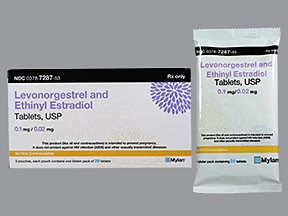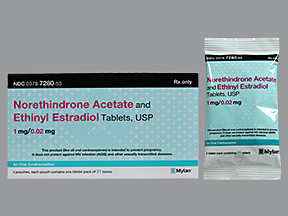PROGESTIN/ESTROGEN CONTRACEPTIVE - ORAL
PHONETIC PRONUNCIATION: (proe-JES-tin/ES-troe-jen)
GENERIC NAME(S): norethindrone-ethinyl estradiol
Uses
USES: This combination hormone medication is used to prevent pregnancy. It contains 2 hormones: a progestin and an estrogen. It works mainly by preventing the release of an egg (ovulation) during your menstrual cycle. It also makes vaginal fluid thicker to help prevent sperm from reaching an egg (fertilization) and changes the lining of the uterus (womb) to prevent attachment of a fertilized egg. If a fertilized egg does not attach to the uterus, it passes out of the body. Besides preventing pregnancy, birth control pills may make your periods more regular, decrease blood loss and painful periods, decrease your risk of ovarian cysts, and also treat acne. Using this medication does not protect you or your partner against sexually transmitted diseases (such as HIV, gonorrhea, chlamydia).
How to use PROGESTIN/ESTROGEN CONTRACEPTIVE - ORAL
HOW TO USE: Read the Patient Information Leaflet provided by your pharmacist before you start using this product and each time you get a refill. The leaflet contains very important information on when to take your pills and what to do if you miss a dose. If you have any questions, ask your doctor or pharmacist. Take this medication by mouth as directed by your doctor, usually once daily. Pick a time of day that is easy for you to remember, and take your pill at the same time each day. It is very important to continue taking this medication exactly as prescribed by your doctor. With certain brands of birth control pills, the amount of estrogen and progestin in each active tablet will vary at different times in the cycle. Therefore, it is very important that you follow the package instructions to find the first tablet, start with the first tablet in the pack, and take them in the correct order. Do not skip any doses. Pregnancy is more likely if you miss pills, start a new pack late, or take your pill at a different time of the day than usual. Vomiting or diarrhea can prevent your birth control pills from working well. If you have vomiting or diarrhea, you may need to use a back-up birth control method (such as condoms, spermicide). Follow the directions in the Patient Information Leaflet and check with your doctor or pharmacist for more details. Taking this medication after your evening meal or at bedtime may help if you have stomach upset or nausea with the medication. You may choose to take this medication at another time of day that is easier for you to remember. No matter what dosing schedule you use, it is very important that you take this medication at the same time each day, 24 hours apart. Ask your doctor or pharmacist if you have any questions. Your pill pack contains 21 pills with active medication. It may also contain 7 reminder pills with no medication. Take one active pill (with hormones) once daily for 21 days in a row. If you are using a product with 28 tablets, take an inactive pill once daily for 7 days in a row after you have taken the last active pill unless otherwise directed by your doctor. If you are using a product with 21 tablets, do not take any tablets for 7 days unless otherwise directed by your doctor. You should have your period during the fourth week of the cycle. After you have taken the last inactive tablet in the pack or gone 7 days without taking an active tablet, start a new pack the next day whether or not you have your period. If you do not get your period, consult your doctor. If this is the first time you are using this medication and you are not switching from another form of hormonal birth control (such as patch, other birth control pills), take the first tablet in the pack on the first Sunday following the beginning of your menstrual period or on the first day of your period. If your period begins on a Sunday, begin taking this medication on that day. For the first cycle of use only, use an additional form of non-hormonal birth control (such as condoms, spermicide) for the first 7 days to prevent pregnancy until the medication has enough time to work. If you start on the first day of your period, you do not need to use back-up birth control the first week. Ask your doctor or pharmacist about how to switch from other forms of hormonal birth control (such as patch, other birth control pills) to this product. If any information is unclear, consult the Patient Information Leaflet or your doctor or pharmacist.
Side Effects
Precautions
Interactions
Overdose
Images

- color
- multi-color (2)
- shape
- round
- imprint
- 227 or 292

- color
- multi-color (2)
- shape
- round
- imprint
- 227 or 292

- color
- multi-color (2)
- shape
- round
- imprint
- 201 or 271

- color
- multi-color (2)
- shape
- round
- imprint
- 253 or 306

- color
- multi-color (2)
- shape
- round
- imprint
- 252 or 302

- color
- multi-color (2)
- shape
- round
- imprint
- 252 or 302

- color
- multi-color (2)
- shape
- round
- imprint
- 245 or 302

- color
- multi-color (2)
- shape
- round
- imprint
- 245 or 302
Reviews
Faq for PROGESTIN/ESTROGEN CONTRACEPTIVE - ORAL
A progesterone/estrogen oral contraceptive, commonly known as the combination pill, is a type of birth control method that contains both the hormones progesterone and estrogen. It is taken orally to prevent pregnancy.
This contraceptive works by inhibiting the release of an egg from the ovaries (ovulation). It also thickens the cervical mucus, making it difficult for sperm to reach the egg. Additionally, it alters the lining of the uterus, making it less receptive to implantation.
Some common brand names for this type of contraceptive include Ortho Tri-Cyclen, Yasmin, Microgestin, Alesse, and Loestrin.
When used correctly, this contraceptive has a 99% effectiveness rate. However, typical use may result in a lower effectiveness rate due to factors such as missed doses or drug interactions.
Common side effects may include nausea, breast tenderness, bloating, mood changes, breakthrough bleeding, and decreased libido. Serious side effects are rare but can include blood clots, stroke, and high blood pressure.
No, this contraceptive only protects against pregnancy and does not provide protection against STIs. It is important to use a barrier method, such as condoms, to reduce the risk of contracting STIs.
Certain medications, such as antibiotics, antifungals, anticonvulsants, and St. John's wort, may interfere with the effectiveness of this contraceptive. It is essential to consult with a healthcare provider about potential drug interactions.
The specific instructions may vary depending on the brand, but generally, if one pill is missed, it should be taken as soon as remembered, even if it means taking two pills in one day. If two or more pills are missed, it is important to refer to the package insert or consult with a healthcare provider for guidance.
While some combination pills are safe to use while breastfeeding, it is important to consult with a healthcare provider to determine the most appropriate contraceptive method, as certain hormones can affect milk production.
Warning
WARNING: Do not use this medication if you smoke cigarettes/use tobacco and are over 35 years old. Smoking raises your risk of stroke, heart attack, blood clots, and high blood pressure from hormonal birth control (such as the pill, patch, ring). The risk of these serious problems increases with age and with the number of cigarettes you smoke. Do not smoke or use tobacco.
Disclaimer
IMPORTANT: HOW TO USE THIS INFORMATION: This is a summary and does NOT have all possible information about this product. This information does not assure that this product is safe, effective, or appropriate for you. This information is not individual medical advice and does not substitute for the advice of your health care professional. Always ask your health care professional for complete information about this product and your specific health needs.

No Reviews Yet